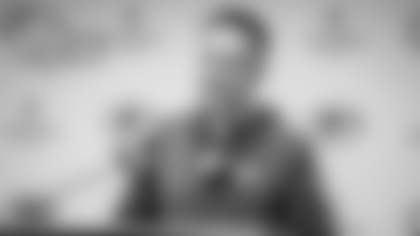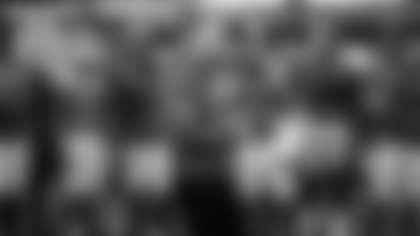Matt from Berkeley, CA
How much thought does the league give to fostering rivalries?
Vic: The Bears and Packers on national TV on Christmas night? There's your answer, Matt. The league is built on rivalries because the league is all about creating great theater, and rivalries are great theater.
Damian from Superior, WI
How do the coaches communicate to the players who are to be on the field for the next play? There seems to be little time for what's often a lot of shuffling.
Vic: That's an astute observation, Damian. When I hear people complain about the play-calling, I can't help but wonder what they would do if they had to stand in front of 70,000 people with the game on the line and coordinate the player substitutions and communicate the play-call in the few seconds before the quarterback's helmet communicator is turned off. There's no time to start dreaming up plays. You have no choice but to work from your script and that's what coaches do. The plays on their script were rehearsed during the week and so were the personnel groupings that accompany each play-call. The play-caller makes the play-call and his assistants along the sideline hear the play-call and provide the appropriate personnel groupings. This is an especially difficult task on defense because the personnel groupings can vary greatly. A defensive assistant will call out "nickel" or "dime" or "goal line," and the players in those sub packages must spring to life so the team doesn't get caught short-handed and have to call a time out. It's not just as simple as thinking up a play. You have to coordinate all of the elements that go with executing that play.
Brent from Stillman Valley, IL
What is your take on quarterback draft picks over the past few years? It seems as if they are all busts if they can't produce in their first year.
Vic: Aaron Rodgers is a bust? My philosophy on quarterbacks is "pick and stick." In other words, pick a guy and stick with him because that's the only way he can develop his talents and establish himself as the leader of your team, which he must be. You have to commit to him. You have to be patient with him. In Rodgers' case, the commitment was made while he was learning how to play the position in practice. Roethlisberger was thrown into the fire right away. Brady spent a year on the bench. Manning played right away. Rivers spent time on the bench. What do they all have in common? A commitment was made to them. Even Brady, who was a sixth-round pick, was handed the job for good. Bill Belichick was criticized for not going back to Bledsoe when Bledsoe was healthy, but Belichick knows you have to pick and stick. Your team has to know who its quarterback is.
Mark from Yucaipa, CA
What the heck are you going to write about after the draft is over? I don't envy your task.
Vic: You pick the subject. Keep asking questions, please.
Bill from Sterling, VA
With the Packers having a president and CEO and not an owner, does Mark Murphy represent the Packers any differently than the other owners during the lockout? Thanks for all your great answers.
Vic: Murphy represents the Packers as any other owner, CEO or president represents the other 31 teams in the league.
Patrick from Bakersfield, CA
The transition from Favre to Rodgers for the Packers went as well as anyone could have hoped, given the Packers' continued high level of play and leadership from the QB position. Can any other team in the NFL compare to the Packers' QB play over the last 20 years?
Vic: I would agree that the performance the Packers have gotten at the quarterback position tops the league over the past 20 years. The Patriots with Bledsoe and Brady are certainly a candidate. Harbaugh and Manning is a good one-two punch.
Patrick from Bloomer, WI
I have noticed almost every mock draft has Green Bay picking a defensive back or defensive lineman. With how many times Rodgers has been hurried, knocked down and sacked, wouldn't the smart thing be to pick up someone to help with the pass-protection and also help out in the run game, in which the Packers really haven't had a strong one in years?
Vic: We've kind of gone over this a million times, but what the heck, let's do it again. I don't think in terms of positions, I think in terms of players that fit, and I believe Ted Thompson thinks that way, too. So, when I look at the draftniks' boards, it appears that defensive and offensive linemen fit at the bottom of the first round. That's also about where the second tier of wide receivers surfaces and it's about where the bulk of the running backs begin to fit.
Tony from Ironwood, MI
Do you think NFL teams on average have had more success converting bigger players to play faster positions from college to the pros (defensive end to linebacker), or smaller players to play bigger positions (safety to linebacker)? I'm just wondering if you'd have any idea what the success rates would be by converting bigger guys to play faster, or smaller guys to play bigger.
Vic: You're describing tweeners; guys whose size/speed ratios will likely force them to make a position change in the NFL. My guess is that there's a higher percentage of college defensive ends that successfully make the move to linebacker than safeties making the move to linebacker, as Brian Urlacher did. Simply put, I think the numbers attempting to go from end to linebacker are much greater than those going from safety to linebacker. College football plays a lot of 52-type defense, in which the ends are more or less linebackers. Hugh Green and Ricky Jackson were ends in a 52, so the transition to linebacker was seamless. I think Kevin Greene was a 52 end at Auburn. He was a big hit right away with the Rams, but then they moved him off the ball and it wasn't his cup of tea. Dom Capers moved him back into a 3-4 rush position and Greene's career blossomed again. Frank Zombo was a 43 end at Central Michigan, so he's proof that true ends can make the move, too, if they have the speed and hips to play in space. Another big consideration here is that ends moving to linebacker have the size to play against the run, which means they can be every-down players. Safeties moving to linebacker tend to be sub-package players because they lack the size to play against the run.
Tim from Tucson, AZ
I'm perplexed on this CBA stuff. I believe each side has legitimate gripes but can't understand why it seems like so much of the media seems to side with the players. Is it as simple as disliking the wealthier side?
Vic: I don't get that feeling that the media is picking sides. I get the feeling the media and the fans are generally upset that any of this is happening. We all want peace and the question I'm sensing that's on everyone's lips, even on the lips of a lot of people inside the league, is: Can't we just share the wealth? I'll tell you where I stand on this: The 2006 CBA was a bad deal. That's the problem. The owners agreed to a really bad deal and it's tough to undo that kind of thing.
Bart from Bartlett, IL
I did some research and found some rather surprising stuff. We were wondering about the uniforms and it turns out the original ones were Notre Dame blue and gold and the team, the "Acme Packers," was even referred to as the "Blues." We wondered why and when it changed to green and gold. Well, it turns out that it happened in 1950, seemingly in order to signal a change from a certain person's era. Let's just say that things appear to not have ended amicably between the team and another Packers legend. Can you provide more detail about this apparently hidden chapter in Green Bay history? "In 1946, Lambeau purchased Rockwood Lodge, creating the first self-contained training facility in professional football. The purchase was controversial among the Packers' board of directors, and Lambeau's deteriorating relationship with the board was one of the factors that would lead to his departure in early 1950."
Vic: In 1949, Curly Lambeau began his efforts at assembling an ownership group to purchase the Packers and move the team to Los Angeles. Lambeau was unable to assemble an ownership group and he left the team, which went into a dark period until the arrival of Vince Lombardi in 1959. Lombardi saved the franchise.
Rick from Prairie du Sac, WI
What players from the Wisconsin Badgers will get drafted and in what rounds?
Vic: Defensive end J.J. Watt and offensive tackle Gabe Carimi lead the way. They're first-round prospects. Guard John Moffitt is a middle-rounds prospect. Tight end Lance Kendricks is a mid- to late-rounds prospect. Cornerback Niles Brinkley, guard Bill Nagy, linebacker Blake Sorenson, quarterback Scott Tolzien, safety Jay Valai and wide receiver Isaac Anderson are all late-rounds prospects. The guy for whom there seems to be a great divergence of opinion is running back John Clay. I've seen him mentioned everywhere from a top 10 back to an undrafted guy.














